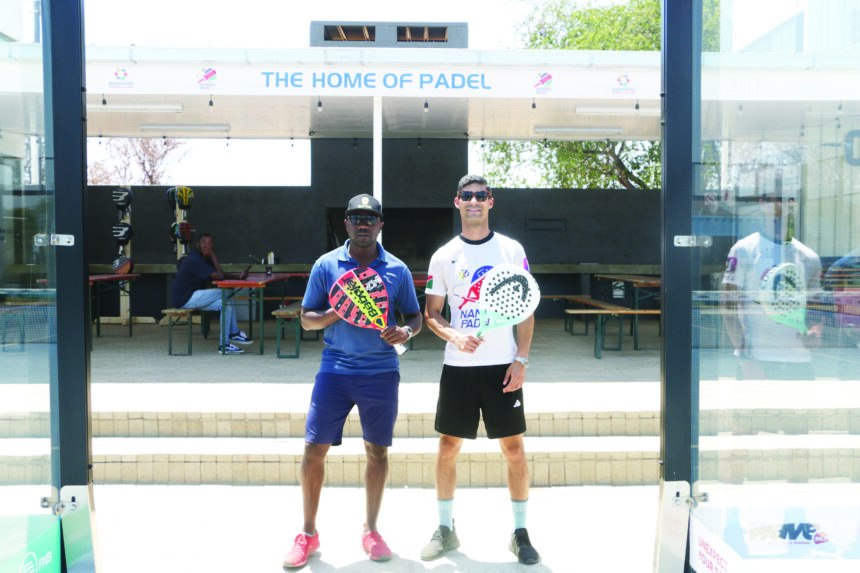With over 10 courts built in the last six months and more expected to be constructed in the coming months, padel is taking Namibia by storm.
A sport once reserved for Europe and Latin America is now quickly becoming a favourite here in Namibia. From its casual playability to its fun, social atmosphere, Namibians are joining the global padel movement.
General manager of Wanderers Sports Club Steven Berry said the sport discipline was introduced to Namibia earlier this year by Namibia padel, sparking the potential for the sport to grow in the country.
The club houses a few padel courts in the capital.
The first court was built at DTS earlier this year. Soon after, other sport clubs around Windhoek, such as
Sport Klub Windhoek (SKW) and United, followed suit.
“Padel is officially the fastest-growing sport in the world. Just to give you a bit of background: Germany, in the last two years, closed about 30 tennis clubs, and replaced them with padel courts,” Berry shared.
“It’s taking over the world like crazy. I mean, Johannesburg, alone, has managed to build close to 40 padel courts in the past six months. It’s a sport for the masses and an easy sport to play,” he added.
What is padel, and how is it played?
Padel is a mix between tennis and squash, played on smaller, enclosed courts.
Scoring is like tennis – but unlike tennis, players serve underarm, and can use the walls to bounce the ball, creating a faster, more dynamic game.
Padel was invented in Mexico in the 1960s, and shortly after introduced to Spain, which has since become the sport’s stronghold with over 3.7 million players and more than 22 000 courts.
Padel is played on a smaller court, encased by walls that are an integral part of the game’s strategy.
Unlike tennis, padel uses solid, stringless racquets, and it promotes a style of play that focuses more on strategic placement than brute power.
Typically a doubles game, it emphasises teamwork and social interaction, making it popular among enthusiasts looking for competitive and social play.
The sport has been growing globally, and three years ago in Sweden, there were less than 100 padel courts.
Today, there are over 800, with more than half a million players.
In Namibia, the sport is mostly gaining traction among the white community, where courts are more accessible.
Berry highlighted that one of the reasons for padel’s growing popularity is its simplicity and inclusivity.
Anyone can play, regardless of age, height, race or other factors.
“A lot of people are coming out of retirement to play padel because it’s a sport that is easy to pick up and play. It’s accessible, fun and the ‘in thing’ right now. Everyone is playing it,” he said.
The role of clubs
Several sport clubs, including Wanderers, DTS, United, SKW and The MTC Dome at Swakopmund, are taking strides to build state-of-the-art padel courts, drawing large crowds eager to try out the sport.
Berry said membership at these clubs has skyrocketed, with more people looking for a fun way to stay active.
Some clubs are even considering organising tournaments, adding a competitive edge to the sport.
“There are four courts at Namibia padel. We have two courts here, and we will add more very soon. SKW is in the process of building more courts, as well as Platz Am Meer Waterfront in Swakopmund.
We have also heard that there are courts to be built in Walvis Bay, Otjiwarongo, Tsumeb and other parts of the country, so we expect this sport to be more popular than now in the next eight months,” he added.
Padel’s future in Namibia
With its rising popularity, the future of padel in Namibia looks bright. Clubs are exploring options to introduce padel programmes in schools, and there are talks of creating a national league.
“It’s going to attract a lot of sales at the bar and restaurant, and we expect more business opportunities. We will have coaches who will assist players, and these are the types of opportunities that will come with this new sport.
“We will have free padel for all members at our club, but there is also an effort to get the sport into schools. Many schools, like Windhoek Gymnasium and Afrikaans Private School, are associated with these programmes,” he noted.
Larushka Kruger, the head of competitions at the Namibia Tennis Association, acknowledged the recent increase in the number of padel players, noting that it is an exciting sport for athletes looking to stay active.
However, the association maintained that despite the surge in participants, they are not concerned about the possibility of padel overtaking tennis.
“There has definitely been an increase in padel players, as it’s a new and exciting sport. Padel is more of a social sport, meaning anyone who wants to be more active and have fun can easily join, and it’s not too hard to learn.
“There was some concern that padel could overtake tennis and threaten the number of tennis players in Namibia. However, we don’t believe tennis will ever become extinct, as it’s also a highly social sport, although harder to learn. Tennis may just need to make some adaptations in the future to make it a bit more exciting for younger generations to watch and play,” she said.
What started as a curiosity at a few exclusive clubs has now grown into a sport beloved by Namibians across the country.
The sport is set to continue its rise, bringing families, friends and communities together on the court.
In Johannesburg, 30 padel courts have been built in the last two months, while Germany has replaced 30 tennis clubs with padel clubs, showing the sport’s growth.
Celebrities like David Beckham, Roger Federer, Rafael Nadal, Sylvain Wiltord, and Neymar have also jumped on the padel bandwagon.
– Additional information from BBC
– mkambukwe@nepc.com.na



